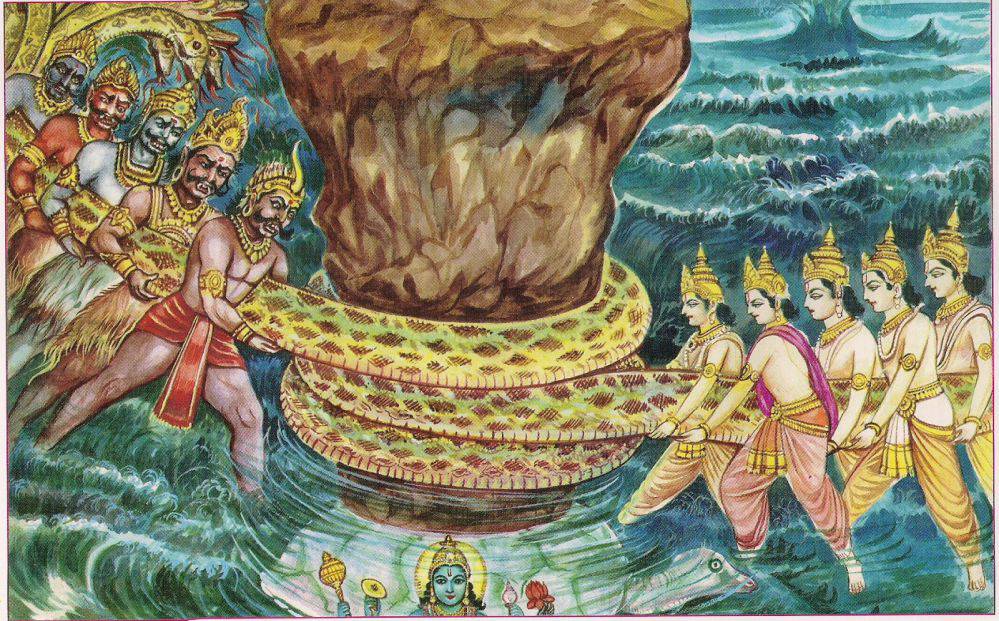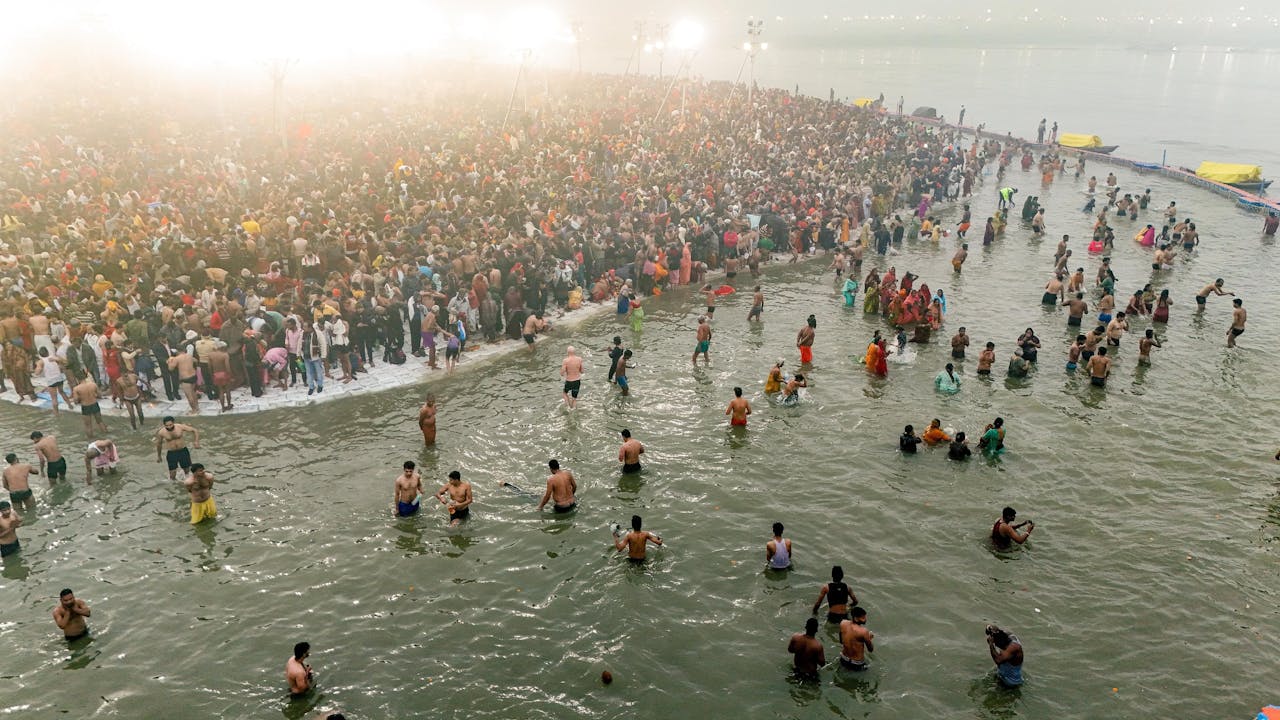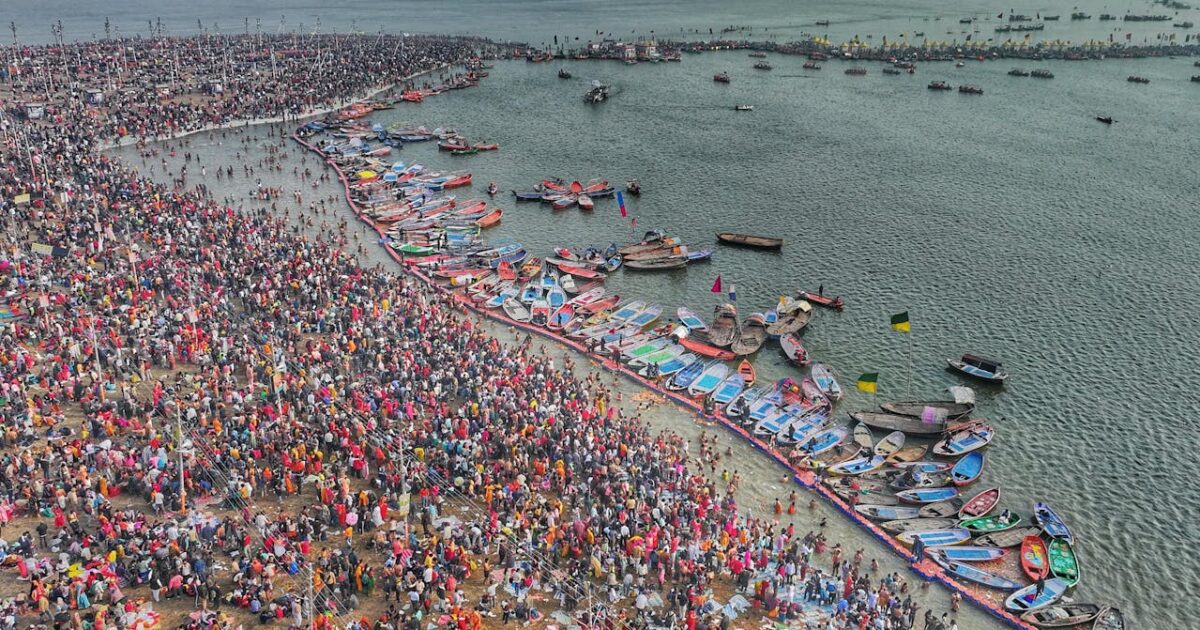Picture millions of people gathered at the sacred Sangam, where the Ganga, Yamuna, and Saraswati rivers meet. The air is filled with the sound of prayers, the smell of incense, and the sight of devotees taking a holy dip. This is Maha Kumbh Mela 2025, the world’s largest festival of faith and spirituality.
It is more than a religious event. It is an experience that connects the past with the present. From holy saints covered in ash to pilgrims seeking blessings, every person here has a purpose. Some come for salvation, others for peace, while many are here to witness something truly magical.
Maha Kumbh is also about stories, culture, and human connections. It brings people from all walks of life together. Whether you come for faith or curiosity, this experience will stay with you forever.
Let me walk you through this amazing journey of devotion and celebration.
Maha Kumbh Mela and its global significance.
Every 12 years, Prayagraj becomes the center of devotion and faith. Millions gather at the Triveni Sangam, the meeting point of three sacred rivers. However, Maha Kumbh 2025 is even more special. It happens once in 144 years, making it a once-in-a-lifetime event.
This festival is the largest religious gathering in the world. It draws pilgrims, saints, and spiritual seekers from every corner of the globe. People believe that bathing in the holy waters washes away sins. It is a journey of faith, discipline, and devotion.
Maha Kumbh is more than a Hindu festival. It is a cultural phenomenon. Scholars, yogis, and travelers come to witness this grand spectacle. The event also attracts photographers, researchers, and spiritual seekers. Faith and tradition blend with modernity, creating an experience that is both timeless and unforgettable.
Before going in further, let’s first learn about Kumbh.
Kumbh Mela Origin – Samudra Manthan and the Nectar of Immortality
The origins of Kumbh Mela trace back to Samudra Manthan.
According to the legend, the Devas had lost their strength due to a curse by Sage Durvasa. Seeking a way to regain their power, they turned to Lord Vishnu, who advised them to churn the ocean of milk (Ksheer Sagar) to extract the nectar of immortality. Since the task was enormous, the Devas sought the help of the Asuras, promising them a share of the Amrit.
For the churning, Mount Mandara was used as the churning rod, and Vasuki, the king of serpents, became the rope. As the churning began, the ocean released many divine and mystical objects, including Kamadhenu (the wish-fulfilling cow), Airavata (Indra’s celestial elephant), Kalpavriksha (the tree of life), Lakshmi (the goddess of wealth), and Varuni (the goddess of wine).

However, it also produced the deadly Halahala poison, which had the power to destroy the entire universe. To save creation, Lord Shiva consumed the poison, holding it in his throat, turning it blue. Thus earning him the name Neelkanth (the blue-throated one).
Finally, after much effort, Dhanvantari, the divine physician, emerged from the ocean holding the pot (Kumbh) of Amrit. The moment the nectar appeared, the Devas and Asuras began fighting fiercely for possession. Fearing that the demons would seize it, the gods sought Vishnu’s help once again. Lord Vishnu took the enchanting form of Mohini, a celestial maiden of unmatched beauty, and tricked the Asuras into handing over the nectar.
As Mohini distributed the Amrit among the Devas, the Asuras realized the deception and attacked. In the battle that followed, drops of the sacred nectar spilled onto four places on Earth; Prayagraj, Haridwar, Ujjain, and Nashik.
These places became sanctified forever, and it is believed that the waters here hold traces of the divine Amrit. This is why Kumbh Mela is celebrated at these locations in cycles, attracting millions of devotees who seek spiritual purification.
Why is Maha Kumbh Mela 2025 Special?

Maha Kumbh 2025 is not just another Kumbh. It marks the completion of 12 full Kumbh Mela cycles—something that happens once in 144 years. This makes it one of the most significant spiritual gatherings of our time.
The event is aligned with a rare planetary positioning. The Sun, Moon, Jupiter, and Saturn will align with Pushya Nakshatra, making this Maha Kumbh even more auspicious. According to astrologers, this celestial setup enhances the power of prayers, making spiritual practices more effective.
Rare Planetary Alignment and Astrological Significance
Astrology plays a key role in determining the timing of the Maha Kumbh. The 2025 event is considered the most auspicious due to a powerful planetary alignment that occurs only once in 144 years. The alignment includes:
- Jupiter in Aries (Mesh Rashi)
- Sun in Capricorn (Makar Rashi)
- Moon in Capricorn (Makar Rashi)
- Saturn’s influence strengthening the spiritual energy
- Pushya Nakshatra enhancing the divine vibrations
This rare combination amplifies the spiritual potency of the Maha Kumbh, making it the most sacred time for purification and liberation. It is believed that taking a dip at the Triveni Sangam during this alignment multiplies the benefits of the holy bath, washing away past sins and bringing salvation.
Spiritual Leaders’ Views on Maha Kumbh 2025
Renowned saints and spiritual leaders emphasize that the Maha Kumbh is not just an event but a cosmic moment of awakening. According to them, the alignment of celestial bodies creates an energetic gateway that allows devotees to elevate their spiritual consciousness. Many believe that bathing in the Sangam during this time does not just cleanse the soul but also helps one break free from the cycle of birth and death.
The gathering of saints, yogis, and sages during this event adds to its divine intensity. The presence of revered Naga Sadhus, Akharas, and learned scholars transforms the Maha Kumbh into a spiritual powerhouse, making it a magnet for seekers from all over the world.
A Spiritual and Cultural Phenomenon
Maha Kumbh Mela is more than a festival—it is a celestial alignment, a spiritual awakening, and a cultural confluence. The 2025 event is expected to witness a record-breaking footfall of over 400 million pilgrims, making it the largest gathering of humanity on Earth. The scale, energy, and spiritual significance make this a once-in-many-lifetime experience.
Among all the Kumbh gatherings, Maha Kumbh is the most powerful and rarest, occurring once every 144 years. The connection to the divine nectar makes this event more than just a pilgrimage—it is a living bridge between mythology and faith, drawing seekers from all walks of life to experience something beyond time and existence.
The scale of Maha Kumbh 2025 is also unprecedented. Over 40 crore devotees are expected to visit, making it the biggest gathering in history. The government has prepared extensively—better roads, advanced security, and improved sanitation will ensure a smoother experience for visitors.
For devotees, taking a dip in the Triveni Sangam during this Maha Kumbh is believed to be more powerful than ever before. It is a chance to cleanse sins, seek blessings, and be part of an event that won’t happen in 144 years.
Rituals and Sacred Bathing at Maha Kumbh 2025
Maha Kumbh Mela revolves around sacred rituals, with bathing in the holy waters being the most significant. Devotees believe that taking a dip in the Triveni Sangam during this time cleanses sins and grants spiritual liberation. The ritual baths follow specific dates, determined by astrological alignments, making each bath highly auspicious.
Shahi Snan: The Heart of Maha Kumbh
The Shahi Snan, or Royal Bath, is the most important ritual of the Kumbh Mela. It marks the grand procession of Naga Sadhus and Akharas, who take the first dip in the holy waters. This event symbolizes the victory of spirituality over material life. The Shahi Snan is a sight to behold, as saints, sadhus, and devotees chant sacred hymns while marching towards the river in a divine spectacle.
Important Bathing Dates and Their Significance
- Paush Purnima (13 January 2025) – Marks the beginning of the sacred bathing rituals. Devotees start their Kalpavas, a period of spiritual discipline and meditation.
- Makar Sankranti (14 January 2025) – A highly auspicious day when the Sun enters Capricorn. Bathing on this day is believed to bring immense blessings.
- Mauni Amavasya (29 January 2025) – Considered the most powerful bathing day. It is believed that on this day, the gods themselves descend to the Sangam, making the waters even more divine.
- Basant Panchami (3 February 2025) – Associated with Goddess Saraswati, this day is considered favorable for seeking wisdom and enlightenment.
- Maghi Purnima (12 February 2025) – A full moon day marking the end of Kalpavas. Bathing on this day grants peace and prosperity.
- Maha Shivaratri (26 February 2025) – Dedicated to Lord Shiva, this bath is believed to cleanse negative karma and lead to spiritual awakening.
Role of Naga Sadhus and Akharas
The Naga Sadhus, known for their ascetic lifestyle, are the most revered participants of Kumbh Mela. They belong to different Akharas (spiritual sects) and live in extreme conditions, renouncing worldly attachments. Their Shahi Snan is the first and most sacred, as it represents the cleansing of the world’s sins.
Akharas, the monastic orders of Hinduism, play a crucial role in the spiritual activities of the Kumbh. They organize discourses, rituals, and processions, offering devotees a glimpse into the ancient traditions of Sanatan Dharma. Each Akhara follows its own customs, but all unite in their devotion to the divine.
The ritual baths of Maha Kumbh 2025 are more than just traditions—they are an opportunity for millions to connect with their faith, cleanse their souls, and experience a rare celestial event.
The Cultural and Spiritual Experience at Maha Kumbh 2025
Maha Kumbh Mela is more than just a religious gathering—it is a grand confluence of philosophy, music, tradition, and spirituality. While the sacred baths remain central, the event also serves as a platform for cultural exchange, spiritual awakening, and deep philosophical discussions. People from different walks of life, across nations and beliefs, come together, making Maha Kumbh a truly universal celebration of faith and wisdom.
Beyond Religion: A Spiritual and Cultural Fusion
Maha Kumbh Mela is not limited to Hindu rituals; it is a living representation of India’s diverse spiritual heritage. From Vedic chanting and bhajans to yogic practices and meditation camps, the atmosphere is charged with devotion and knowledge. Pilgrims engage in satsangs (spiritual gatherings), listen to discourses from revered saints, and experience a sense of unity that transcends social and geographical boundaries.
The melodious sounds of bhajans and kirtans, the rhythmic beats of damrus (small drums), and the enchanting scent of incense create an experience that goes beyond the physical realm, immersing visitors in a divine aura.
Sacred Rituals: Ganga Aarti and Spiritual Discourses
Ganga Aarti: A Mesmerizing Spectacle
Every evening, the Ganga Aarti at the Sangam ghats becomes a breathtaking sight. Priests dressed in traditional attire perform synchronized rituals with large brass lamps, chanting Vedic hymns while offering prayers to the holy river.
The glow of a thousand lamps, reflected in the waters of the Ganga and Yamuna, creates a deeply spiritual and visually stunning experience. Devotees release small oil lamps (diyas) into the river, symbolizing their prayers and wishes.
Katha and Discourses: Seeking Wisdom
The Maha Kumbh hosts several spiritual discourses (Kathas) led by eminent saints and scholars from different sects. These sessions delve into ancient scriptures, covering topics like the Bhagavad Gita, Vedanta, and Bhakti traditions. Devotees listen to these teachings, gaining insights into dharma (righteousness), karma (actions), and moksha (liberation).
Pilgrim Interactions and the Global Appeal
Maha Kumbh Mela is not just an Indian phenomenon—it attracts seekers and scholars from around the world. International devotees, researchers, and tourists visit the festival to witness and experience its grandeur. Many join meditation camps, attend yoga sessions, and interact with saints to learn about ancient wisdom and spiritual practices.
The presence of spiritual leaders from various traditions adds to the significance of the event. From revered Indian gurus to international monks and scholars, Maha Kumbh becomes a hub for cross-cultural and interfaith discussions on spirituality, philosophy, and the meaning of life.
The 2025 Maha Kumbh promises to be a once-in-a-lifetime experience, not just in its religious significance but also as a cultural and spiritual extravaganza. It is a place where devotion meets tradition, where philosophy meets music, and where the human spirit finds unity in diversity.
Modern Infrastructure and Security Measures at Maha Kumbh 2025
With an expected footfall of over 40 crore pilgrims, the Uttar Pradesh government has undertaken massive infrastructure and security upgrades to ensure a smooth and safe experience for all visitors. Maha Kumbh 2025 is set to be the largest and most technologically advanced Kumbh ever, incorporating modern surveillance, AI-driven crowd monitoring, and emergency response systems.
Government Preparations: Roads, Sanitation, and Medical Aid
To accommodate the unprecedented crowd, authorities have focused on improving roads, sanitation, and healthcare facilities across Prayagraj.
- Road and Transport Infrastructure:
- Widening of roads leading to the mela grounds to ease traffic congestion.
- Expansion of railway and airport connectivity for smoother pilgrim arrivals.
- Special public transport services including shuttle buses and e-rickshaws for easy movement within the festival area.
- Sanitation and Cleanliness:
- Thousands of temporary toilets and waste disposal units to maintain hygiene.
- Deployment of cleaning staff and waste management teams working 24/7.
- Water purification systems to provide clean drinking water at multiple locations.
- Medical and Emergency Services:
- Establishment of temporary hospitals and health camps across key locations.
- Round-the-clock availability of ambulances, mobile medical units, and trauma centers.
- Deployment of trained paramedics and doctors for immediate medical attention.
AI-Based Crowd Monitoring and High-Tech Security
Given the massive crowd, AI-powered crowd control systems and drone surveillance will play a crucial role in ensuring safety and preventing mishaps.
- AI-Based Crowd Management:
- Real-time monitoring of crowd density using artificial intelligence.
- Digital signboards and announcements guiding visitors to less crowded areas.
- Predictive analytics to identify potential congestion points and reroute people accordingly.
- Drone Surveillance and Facial Recognition:
- High-resolution drones patrolling the entire mela area for security and lost-person tracking.
- Facial recognition technology at key entry and exit points for identifying missing persons.
- Integrated CCTV networks covering all important ghats, roads, and public areas.
- Emergency Response Teams:
- Deployment of NDRF (National Disaster Response Force) and Quick Response Teams for disaster management.
- Special fire safety and rescue units stationed near key locations.
- Helpline centers and lost-and-found booths to assist pilgrims.
Special Arrangements for International Visitors
Recognizing the global appeal of Maha Kumbh, special zones and facilities have been set up to accommodate international visitors.
- Dedicated International Tourist Centers:
- Separate help desks with multilingual staff for seamless assistance.
- Special accommodations in designated guest areas with proper amenities.
- Curated guided tours to help visitors navigate the festival smoothly.
- Cultural Orientation Programs:
- Sessions explaining rituals, customs, and significance of Maha Kumbh.
- Introduction to Indian spirituality, yoga, and meditation camps.
Maha Kumbh 2025 is not only a spiritual and cultural marvel but also a technological and logistical feat. With state-of-the-art infrastructure, AI-driven security, and global outreach, this Kumbh is set to be the most well-organized and accessible in history.
How to Reach Prayagraj: Best Travel Routes and Transport Options
Prayagraj is well connected by air, rail, and road, making it accessible from all parts of India and abroad.
1. By Air: Nearest Airports
- Prayagraj Airport (IXD) – Closest airport, 15 km from the city center.
- Varanasi Airport (VNS) – 120 km away, offers more flight options, including international routes.
- Lucknow Airport (LKO) – 200 km away, another alternative with better connectivity.
- Special shuttle services and cabs will be available from these airports to Prayagraj.
2. By Train: Extensive Rail Connectivity
- Prayagraj Junction (PRYJ) is one of the busiest railway stations, with direct trains from:
- Delhi (Prayagraj Express, Humsafar Express)
- Mumbai (Mahanagari Express, Kamayani Express)
- Kolkata (Howrah Express, Duronto Express)
- Chennai, Bangalore, and other major cities.
- Additional special trains will be introduced during Maha Kumbh 2025.
3. By Road: Major Highways & Bus Services
- Prayagraj is well connected via NH-19 (Delhi-Kolkata Highway) and NH-30 (Varanasi-Lucknow Route).
- State transport buses and private Volvo services are available from nearby cities like Varanasi, Lucknow, and Kanpur.
- Self-drive and rental cabs are also an option for flexibility.
4. Local Transport Within Prayagraj
- Public buses and auto-rickshaws will operate frequently near the mela grounds.
- E-rickshaws and cycle rickshaws provide short-distance transport.
- Foot travel is recommended within mela areas due to high congestion.
Essential Tips for Visitors: Safety, Hygiene, and Cultural Etiquette
1. Safety Tips
- Stay in designated areas and avoid overcrowded locations.
- Use official information booths for assistance.
- Keep emergency numbers and your accommodation details handy.
- Travel in groups, especially during peak bathing days.
2. Hygiene and Health Precautions
- Drink only bottled or filtered water to avoid waterborne diseases.
- Use public toilets and sanitation facilities provided by the government.
- Carry wet wipes, sanitizers, and basic medicines.
- Wear comfortable footwear suitable for long walks.
3. Cultural Etiquette
- Respect the sanctity of rituals and religious customs.
- Seek permission before clicking photographs of saints and sadhus.
- Follow dress codes – modest attire is recommended.
- Avoid bringing non-vegetarian food and alcohol to the mela grounds.
Summing Up
Mahakumbh 2025 has once again demonstrated the grandeur of faith, culture, and spirituality on an unparalleled scale. With millions of devotees gathering at the sacred Triveni Sangam, the event transcended religious boundaries and became a testament to India’s deep-rooted traditions. The participation of political leaders, international dignitaries, saints, celebrities, and sports icons highlighted its global significance.
Beyond the spiritual aspect, Mahakumbh 2025 served as a platform for cultural exchange, religious discourse, and social harmony. The presence of foreign delegations and extensive media coverage reinforced its reputation as the world’s largest spiritual congregation. As the festival concluded, it left behind a legacy of devotion, unity, and collective consciousness, inspiring generations to come.




